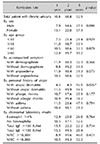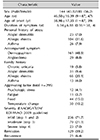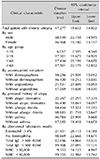1. Sahiner UM, Civelek E, Tuncer A, Yavuz ST, Karabulut E, Sackesen C, et al. Chronic urticaria: etiology and natural course in children. Int Arch Allergy Immunol. 2011; 156:224–230.


2. van der Valk PG, Moret G, Kiemeney LA. The natural history of chronic urticaria and angioedema in patients visiting a tertiary referral centre. Br J Dermatol. 2002; 146:110–113.


3. Kang HS, Shin MY. Clinical aspects of chronic urticaria in children. Korean J Pediatr. 2009; 52:205–212.

5. Toubi E, Kessel A, Avshovich N, Bamberger E, Sabo E, Nusem D, et al. Clinical and laboratory parameters in predicting chronic urticaria duration: a prospective study of 139 patients. Allergy. 2004; 59:869–873.


6. Najib U, Bajwa ZH, Ostro MG, Sheikh J. A retrospective review of clinical presentation, thyroid autoimmunity, laboratory characteristics, and therapies used in patients with chronic idiopathic urticaria. Ann Allergy Asthma Immunol. 2009; 103:496–501.


7. Najib U, Sheikh J. The spectrum of chronic urticaria. Allergy Asthma Proc. 2009; 30:1–10.


8. Lee EA, Kim HS, Lee JY, Kim HO, Park YM. Analysis of the effect of oral antihistamines in patients with chronic urticaria in terms of the disease outcome and quality of life. Korean J Dermatol. 2010; 48:758–765.
9. Kozel MM, Mekkes JR, Bossuyt PM, Bos JD. Natural course of physical and chronic urticaria and angioedema in 220 patients. J Am Acad Dermatol. 2001; 45:387–391.


10. Lee SY, Song WJ, Jung JW, Park HW, Cho SH, Min KU, et al. Thyroid autoantibodies and the prognosis of chronic idiopathic urticaria. Allergy Asthma Respir Dis. 2013; 1:151–156.

13. Sánchez J, Sánchez A, Cardona R. Causal relationship between Anti-TPO IgE and chronic urticaria by in vitro and in vivo tests. Allergy Asthma Immunol Res. 2019; 11:29–42.

14. Greaves M. Chronic urticaria. J Allergy Clin Immunol. 2000; 105:664–672.


15. Frank MM. 8. Hereditary angioedema. J Allergy Clin Immunol. 2008; 121:S398–S401.

16. Humphreys F, Hunter JA. The characteristics of urticaria in 390 patients. Br J Dermatol. 1998; 138:635–638.


17. Quaranta JH, Rohr AS, Rachelefsky GS, Siegel SC, Katz RM, Spector SL, et al. The natural history and response to therapy of chronic urticaria and angioedema. Ann Allergy. 1989; 62:421–424.

18. Juhlin L. Recurrent urticaria: clinical investigation of 330 patients. Br J Dermatol. 1981; 104:369–381.


20. Champion RH, Roberts SO, Carpenter RG, Roger JH. Urticaria and angio-oedema. A review of 554 patients. Br J Dermatol. 1969; 81:588–597.

21. Kulthanan K, Jiamton S, Thumpimukvatana N, Pinkaew S. Chronic idiopathic urticaria: prevalence and clinical course. J Dermatol. 2007; 34:294–301.

22. Kim S, Baek S, Shin B, Yoon SY, Park SY, Lee T, et al. Influence of initial treatment modality on long-term control of chronic idiopathic urticaria. PLoS One. 2013; 8:e69345.

23. Park HH, Lee JY, Song AR, Jung MY, Kim MJ, Sohn IS, et al. Natural course and prognostic factors of chronic urticaria in Korean children: a single center experience. Asian Pac J Allergy Immunol. 2019; 37:19–24.


24. Olze H, Zuberbier T. Comorbidities between nose and skin allergy. Curr Opin Allergy Clin Immunol. 2011; 11:457–463.


25. Darlenski R, Kazandjieva J, Zuberbier T, Tsankov N. Chronic urticaria as a systemic disease. Clin Dermatol. 2014; 32:420–423.


26. Ye YM, Jin HJ, Hwang EK, Nam YH, Kim JH, Shin YS, et al. Co-existence of chronic urticaria and metabolic syndrome: clinical implications. Acta Derm Venereol. 2013; 93:156–160.


27. Böhme M, Lannero E, Wickman M, Nordvall SL, Wahlgren CF. Atopic dermatitis and concomitant disease patterns in children up to two years of age. Acta Derm Venereol. 2002; 82:98–103.


28. Magen E, Mishal J, Schlesinger M. Clinical and laboratory features of chronic idiopathic urticaria in the elderly. Int J Dermatol. 2013; 52:1387–1391.


29. Champion RH. Urticaria: then and now. Br J Dermatol. 1988; 119:427–436.


30. Kozel MM, Bossuyt PM, Mekkes JR, Bos JD. Laboratory tests and identified diagnoses in patients with physical and chronic urticaria and angioedema: a systematic review. J Am Acad Dermatol. 2003; 48:409–416.


32. Zuberbier T, Chantraine-Hess S, Hartmann K, Czarnetzki BM. Pseudoallergen-free diet in the treatment of chronic urticaria. A prospective study. Acta Derm Venereol. 1995; 75:484–487.











 PDF
PDF ePub
ePub Citation
Citation Print
Print







 XML Download
XML Download